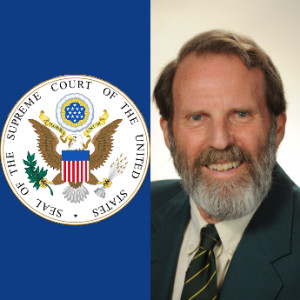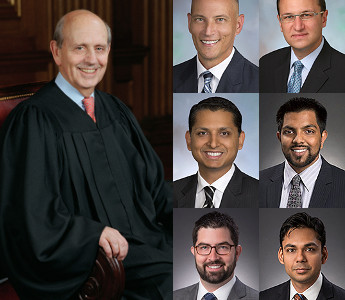United States v. Texas, 579 U.S. ___ (2016) (per curiam).
Response by Alan Morrison
Geo. Wash. L. Rev. On the Docket (Oct. Term 2015)
Slip Opinion | N.Y. Times | SCOTUSblog
Ambush or Self-Inflicted Wound: Defending the Administration’s Deferred Action Program
When federal judge Andrew Hanen enjoined the Obama Administration’s expanded deferred action program last February,1 it seemed like an ambush. The State of Texas snuck up on the Administration with a novel standing theory—it would have to issue driver’s licenses to a half a million of the program’s beneficiaries at a net cost of $174.73 each to the state—and the court agreed that a policy statement from the Department of Homeland Security was really a substantive rule that could only go into effect after allowing the public to comment on it for at least thirty days as required by the Administrative Procedure Act (“APA”).2 Moreover, although Texas was the only state that made the license claim, the judge issued an order that stopped the program across the entire country.
The Administration appealed, was denied a stay of the preliminary injunction order, and in a 2-1 decision, the Fifth Circuit affirmed.3 For good measure, the majority opined that the whole program was illegal, even though the only basis for the trial judge’s order, and the only basis on which either court found standing, was on the procedural right to comment on the program’s wisdom and legality before it went into effect. The Administration immediately announced that it would seek Supreme Court review, and this week, by a 4-4 vote, the lower court decision was upheld,4 and the case was remanded to the district court for further proceedings on the merits.
Strictly on the law, the lower court rulings should be reversed, although, on the procedural issues, that is not as clear (as some have suggested). But there is a more basic question: does the Administration want vindication on its legal arguments, or does it want to be able to make available to some 4.3 million deportable aliens the right to be legally employed and receive other benefits immediately, while Congress and the President seek a long term solution to what to do with 11 million aliens who are in this country illegally? If the answer is, as it should be, the latter, there are two steps that the Administration could take tomorrow that would thoroughly undercut the basis for the adverse rulings against it.
First, it could publish Homeland Secretary Jeh Johnson’s five-page memorandum outlining the program as a proposed rule and ask for public comment on it, while still maintaining that it is a statement of policy exempt from the thirty-day notice and comment requirement under the APA that the lower courts found was applicable. Once that thirty-day period is concluded, the statement could be issued as a final rule, and the procedural objection would vanish. Yes, I know that the rulemaking process is very slow, but I find it hard to believe that an agency that really wanted to get a rule out in a short period of time could not find some way to do it. That would take care of the district judge’s objections to the program, but because a majority of the court of appeals found that the program was not authorized by law, a second step may be needed.
The only basis on which the appeals court found standing was the cost that Texas claimed was imposed on it because the program would entitle the beneficiaries to state driver’s licenses which, according to the Texas accounting system, actually cost the state $174.73 for every license issued. The Administration argued both that this was a self-inflicted injury because Texas could avoid it by raising the price for everyone, not just aliens, and, in the alternative, that federal law does not require Texas to issue these licenses to beneficiaries of the expanded deferred action program. There is nothing that the Administration can do unilaterally about the cost of a driver’s license in Texas, but it can surely fix the uncertainty over a state’s obligation to issue driver’s licenses to those granted deferred action. Thus, when DHS carries out step one and invites public comment on the program, it can add to the program an express disclaimer, repeating what it has said from the beginning of this lawsuit: that those found eligible for deferred action have no right, as a matter of federal law, to obtain a state driver’s license. In a single stroke, that would eliminate the claimed injury asserted by Texas. At that point, Texas would have to decide whether to spend the $174.73 per person and issue driver’s licenses to beneficiaries of the deferred action program, but it could no longer blame the Obama Administration for that cost.
To be sure, taking these two steps would not end the litigation. Texas and the other 25 states that joined as plaintiffs would still have their claim that the deferred action program was enacted without any statutory basis, but that is a very difficult claim to win. As a starter, the states would lose the standing argument that has gotten them this far, and it would be a much bigger stretch to find standing on the alternative theory that the Government has abdicated its duty to deport at least four million illegal aliens. In addition, although Judge Hanen blamed “the Government” for that failure,5 he did not acknowledge that, until Congress appropriates the billions of dollars needed to accomplish that task, there is no basis to fault this or any other Administration for its inability to deport any more than 400,000 individuals each year.
The question that the Administration needs to ask is whether it would like its expanded deferred action program to go into effect within roughly sixty days, or take a chance on persuading the Supreme Court to hear its case again and rule in its favor, which would be months, if not years, away. Either route has the potential to escape the ambush, but insisting on obtaining vindication of the Administration’s legal arguments, especially with the 4-4 tie, may result in a self-inflicted injury that could doom a program that can provide real benefits to millions of aliens who are physically in this country, but unable to work legally and support their families.
- Texas v. United States, 86 F. Supp. 591, 677 (S.D. Tex. 2015).
- Administrative Procedure Act, Pub. L. No. 79-404, 60 Stat. 237 (codified as amended in scattered sections of 5 U.S.C.).
- Texas v. United States, 809 F.3d 134, 188 (5th Cir. 2015).
- United States v. Texas, No. 15-674, slip op. (June 23, 2016).
- Texas, 86 F. Supp. at 638.
Recommended Citation:
Alan Morrison, Response, United States v. Texas: Ambush or Self-Inflicted Wound: Defending the Administration’s Deferred Action Program, Geo. Wash. L. Rev. On the Docket (June 28, 2016), http://www.gwlr.org/ambush-or-self-inflicted-wound-defending-the-administrations-deferred-action-program.





